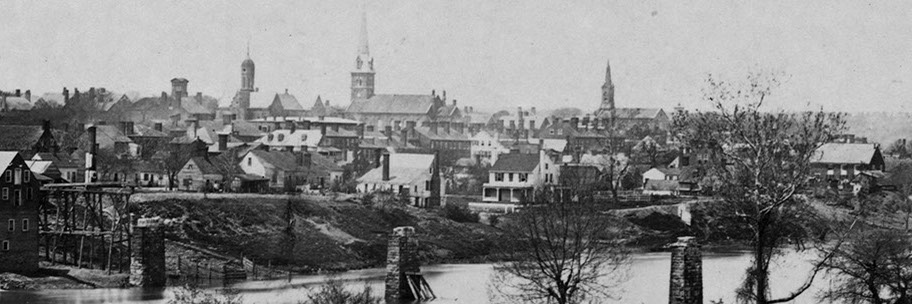
ON THE RIVER AT 801 SOPHIA STREET IN DOWNTOWN FREDERICKSBURG, VIRGINIA

Photograph
Fredericksburg, Virginia, from across the Rappahannock River in 1863
This photo from the Smithsonian archives was taken after the first Battle of Fredericksburg. Shiloh's original brick building is on the banks of the river at the far right in the photo.
Thanksgiving 1865 and the beginning
of an enduring sacred tradition
Since 1865, African Americans — and others — have gathered annually at 6 a.m. on Thanksgiving morning at the corner of Sophia and Hanover streets in Fredericksburg, Virginia. The text below explains how this enduring celebration first began.
Web content copyright © 2015 by Shiloh Baptist Church (Old Site), 801 Sophia Street, Fredericksburg, Virginia 22401
A momentous year, a momentous time
I invite you to imagine with me what life would have been like for early members of this congregation, people of color living in Fredericksburg in 1865, the year that Fredericksburg's first sunrise Thanksgiving service was held. Think of their hopes, their doubts, their dreams, their fears…
Early in 1865, the Civil War was still raging — and the raging wasn’t that far way. Furious battles erupted in Richmond and Petersburg. For a time, it seemed the defenders of slavery would never give up. Again and again, mangled corpses were stacked in piles. Injured soldiers limped and staggered, crying in pain. At one point, early that year, a massive fire raged through Richmond, destroying much of the city. Here in Fredericksburg, bullet-riddled buildings and crumbling brick structures gave witness to deep waves of destruction. Here in town, as well as out in farm fields and nearby woods, bodies — and severed body parts — were still being discovered. Some lay where they had fallen. Some had been interred in shallow, temporary graves. You never knew what you might stumble on.
In March 1865, up in Washington, Abraham Lincoln delivered his second inaugural address. Earlier in the war, President Lincoln had walked these very streets, here in Fredericksburg, perhaps even passed by this corner. And then, just before he began his second term, President Lincoln had pushed through Congress the Thirteenth Amendment, forever outlawing slavery throughout this nation.
At the reception that followed the president’s second inauguration, Frederick Douglass had boldly approached the president — and pressed hard for an extension of the right to vote. Equality demands it, Douglass had said, regardless of color, regardless of past status. News of President Lincoln’s response traveled fast. He had told Frederick Douglass that he would press ahead on that front. He said he’d make it a priority for his second term.
Here in Fredericksburg, as word got out about the president’s dramatic commitment, hopes must have risen among those many who had so recently been enslaved. Yes, their city was in ruins. Yes, they were desperately poor and struggling to survive. Yes, paid work was hard to find. Yes, former “owners” looked with scorn on those noble individuals whom they had formerly treated as “property.” Yes, curses and glares — and worse — were common here on the streets of Fredericksburg in 1865. Life wasn’t easy. But hopes were rising. Spirits, long battered, were beginning to stir.
They must have stirred even more when word came that same year indicating that General Lee had surrendered. Other Confederate generals soon did the same. Perhaps it seemed, for a time, as if someone had cried to the storm from the front of the boat, “Peace! Be still!”
But as is so often the case, even in our own day, a new storm soon appeared. Evil dug in its heels. On Good Friday 1865, those who wanted to “take back their country,” those who were desperately trying to stop justice and righteousness from flowing like a mighty rushing stream, they sprang their trap. Shots rang out. A president lay dead. And people of color in Fredericksburg — and all over this nation — felt assaulted once again.
Just a few weeks later, George Dixon, who had often preached and ministered on this corner before the war, slipped back into town. Early on, to escape enslavement, he and others from this congregation had fled to Washington. It was the summer of 1865 when many returned, though others, fearing for their lives, stayed back in Washington. Their fear was not unfounded, for when hate resides in human hearts, there’s no telling where it might lead. Indeed, it was in that same tumultuous year — 1865 — that former Confederate soldiers secretly organized what came to be known as the Ku Klux Klan.
As autumn arrived, as November 1865 rolled around, Pastor George Dixon asked his flock to join together on the day of thanksgiving, on the actual day that had been designated by the president whose personal commitments had so recently cost him his life. And the only time they could do that was early in the morning, before they all went to work.
Given all that had happened, their gathering on that Thanksgiving in 1865 was certainly not a proud statement of triumph. It was rather an expression of their God-given courage and commitment. Their dreams were still unsettled. Their deepest longings had been splattered with the blood of the slaughtered, and their feet still struggled to move along a way that with tears had been watered. But thanks be to God, they had tasted the substance of things hoped for. They had clasped in their hearts the evidence of things unseen.
For them, as for us, to give thanks in a world that is still broken, to give thanks in a world in which evil still digs in its heels, is a profound act of faith. They were willing to step out of the boat and walk, as it were, across stormy waves toward that new creation to which God is calling us all.
I don’t know about you, but I long to learn from their witness. I long to learn from their courage. Perhaps we all can learn to give thanks not because the journey is over — but because the journey has begun.
— Presented at the 150th anniversary of the Thanksgiving sunrise service by Mark William Olson, November 2015